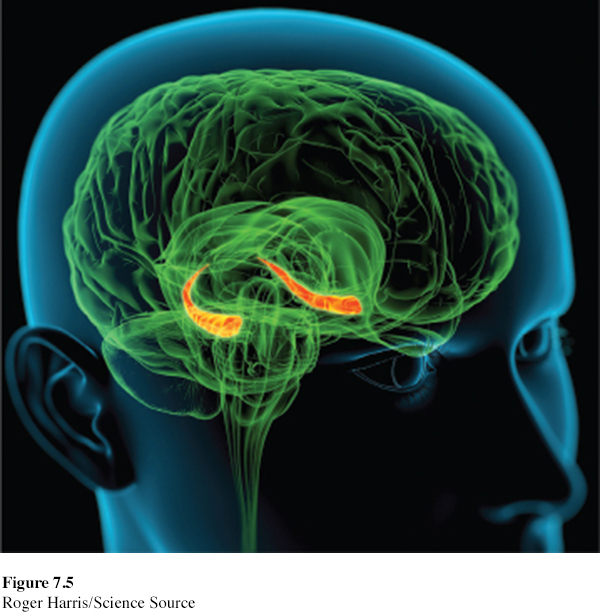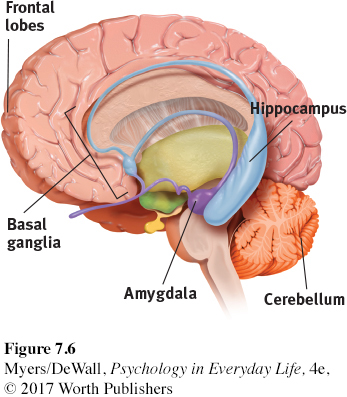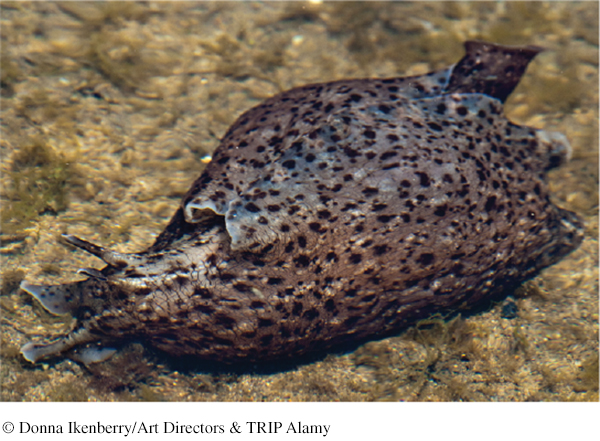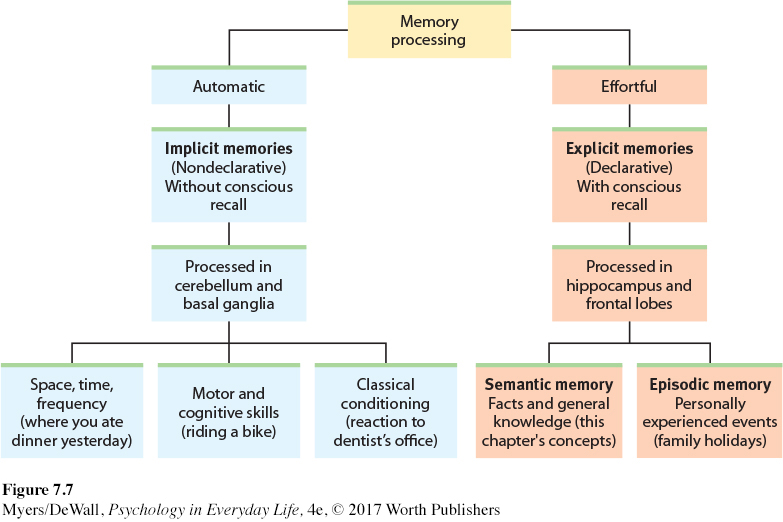7.3 Memory Storage
LOQ 7-
In Arthur Conan Doyle’s A Study in Scarlet, Sherlock Holmes offers a popular theory of memory capacity:
I consider that a man’s brain originally is like a little empty attic, and you have to stock it with such furniture as you choose. . . . It is a mistake to think that that little room has elastic walls and can distend to any extent. Depend upon it, there comes a time when for every addition of knowledge you forget something that you knew before.
Contrary to Holmes’ “memory model,” our capacity for storing long-
Retaining Information in the Brain
I [DM] marveled at my aging mother-
For a time, some surgeons and memory researchers marveled at what appeared to be vivid memories triggered by stimulating the brain during surgery. Did this prove that our whole past, not just well-
Explicit Memory System: The Hippocampus and Frontal Lobes
LOQ 7-
Separate brain regions process our explicit and implicit memories. We know this from scans of the brain in action, and from autopsies of people who suffered different types of memory loss.
semantic memory explicit memory of facts and general knowledge; one of our two conscious memory systems (the other is episodic memory).
episodic memory explicit memory of personally experienced events; one of our two conscious memory systems (the other is semantic memory).
hippocampus a neural center located in the limbic system; helps process explicit memories for storage.
memory consolidation the neural storage of a long-
Explicit, conscious memories are either semantic (facts and general knowledge) or episodic (experienced events). New explicit memories of these facts and episodes are laid down via the hippocampus, a limbic system neural center that is our brain’s equivalent of a “save” button (FIGURE 7.5). Brain scans reveal activity in the hippocampus and nearby brain networks as people form explicit memories of names, images, and events (Squire & Wixted, 2011; Wang et al., 2014). Your hippocampus acts as a loading dock where your brain registers and temporarily stores aspects of an event—


Your brain’s right and left frontal lobes store different information. Recalling a password and holding it in working memory, for example, would activate your left frontal lobe. Calling up a visual image of last night’s party would more likely activate your right frontal lobe.
A good night’s sleep supports memory consolidation, both in humans and in rats. In experiments, rats have learned the location of a tasty new food. If their hippocampus is removed 3 hours after they locate the food, no long-
Implicit Memory System: The Cerebellum and Basal Ganglia
LOQ 7-
You could lose your hippocampus and still—
Your cerebellum, a brain region extending out from the rear of your brainstem, plays an important role in forming and storing memories created by classical conditioning. People with a damaged cerebellum cannot develop some conditioned reflexes. They can’t, for example, link a tone with an oncoming puff of air, so they don’t blink just before the puff, as anyone else would learn to do (Daum & Schugens, 1996; Green & Woodruff-
Your memories of physical skills—
Although not part of our conscious adult memory system, the reactions and skills we learned during infancy reach far into our future. Can you remember learning to talk and walk as a baby? If you cannot, you are not alone. As adults, our conscious memory of our first four years is largely blank, an experience called infantile amnesia. To form and store explicit memories, we need a command of language and a well-
Retrieve + Remember
Question 7.6
•Which parts of the brain are important for implicit memory processing, and which parts play a key role in explicit memory processing?
ANSWER: The cerebellum and basal ganglia are important for implicit memory processing. The hippocampus and frontal lobes are key to explicit memory formation.
Question 7.7
•Your friend has experienced brain damage in an accident. He can remember how to tie his shoes but has a hard time remembering anything you tell him during a conversation. How can implicit vs. explicit information processing explain what’s going on here?
ANSWER: Our explicit conscious memories of facts and episodes differ from our implicit memories of skills (such as tying shoelaces) and classically conditioned responses. The parts of the brain involved in explicit memory processing may have sustained damage in the accident, while the parts involved in implicit memory processing appear to have escaped harm.
The Amygdala, Emotions, and Memory
LOQ 7-
Arousal can sear certain events into the brain (Birnbaum et al., 2004; McGaugh, 2015; Strange & Dolan, 2004). Excitement or stress (perhaps at a time you performed in front of a crowd) triggers your glands to produce stress hormones. By making more glucose energy available to fuel brain activity, stress hormones signal the brain that something important is happening. Stress hormones also focus memory. They provoke the amygdala (two limbic system, emotion-

The resulting emotions often persist without our conscious awareness of what caused them, as one clever experiment demonstrated. The participants were patients with hippocampal damage, which left them unable to form new explicit memories. Researchers first showed them a sad film, and later a happy film. Although these viewers could not consciously recall the films, the sad or happy emotion lingered (Feinstein et al., 2010).
After a horrific experience—
flashbulb memory a clear memory of an emotionally significant moment or event.
Why are some memories so much stronger than others? Emotion-
Which is more important—
Dramatic experiences remain clear in our memory in part because we rehearse them. We think about them and describe them to others. Memories of our best experiences, which we enjoy recalling and recounting, also endure (Storm & Jobe, 2012; Talarico & Moore, 2012). One study invited 1563 Boston Red Sox and New York Yankees fans to recall the baseball championship games between their two teams in 2003 (Yankees won) and 2004 (Red Sox won). Fans recalled much better the game their team won (Breslin & Safer, 2011).
Synaptic Changes
LOQ 7-
As you read this chapter and learn about memory processes, your brain is changing. Activity in some brain pathways is increasing. Neural network connections are forming and strengthening. Changes are taking place at your synapses—
Eric Kandel and James Schwartz (1982) were able to catch a new memory leaving tracks in neurons of the California sea slug. This simple animal’s nerve cells are unusually large, and researchers have been able to observe how they change during learning. Using electric shocks, they have classically conditioned sea slugs to withdraw their gills when squirted with water, much as we might jump at the sound of a firecracker. By observing the slugs’ neural connections before and after this conditioning, Kandel and Schwartz pinpointed changes. As a slug learns, it releases more of the neurotransmitter serotonin into certain neurons. These cells’ synapses then become more efficient at transmitting signals. Experience and learning can increase—

long-
As synapses become more efficient, so do neural networks. Sending neurons now release their neurotransmitters more easily. Receiving neurons may grow additional receptor sites. This increased neural efficiency, called long-
Rats given a drug that enhanced synaptic efficiency (LTP) learned to run a maze with half the usual number of mistakes (Service, 1994).
Drugs that block LTP interfere with learning (Lynch & Staubli, 1991).
Mice that could not produce an enzyme needed for LTP could not learn their way out of a maze (Silva et al., 1992).
After LTP has occurred, an electric current passing through the brain won’t erase old memories. Before LTP, the same current can wipe out very recent memories. This often happens when severely depressed people receive electroconvulsive therapy (Chapter 14). Sports concussions can also wipe out recent memories. Football players and boxers knocked unconscious typically have no memory of events just before the blow to the head (Yarnell & Lynch, 1970). Their working memory had no time to process the information into long-
Recently, I [DM] did a little test of memory consolidation. While on an operating table for a basketball-
FIGURE 7.7 summarizes the brain’s two-

Retrieve + Remember
Question 7.8
•Which brain area responds to stress hormones by helping to create stronger memories?
ANSWER: the amygdala
Question 7.9
•Increased efficiency at the synapses is evidence of the neural basis of learning and memory. This is called _______ - _______ _______.
ANSWER: long-